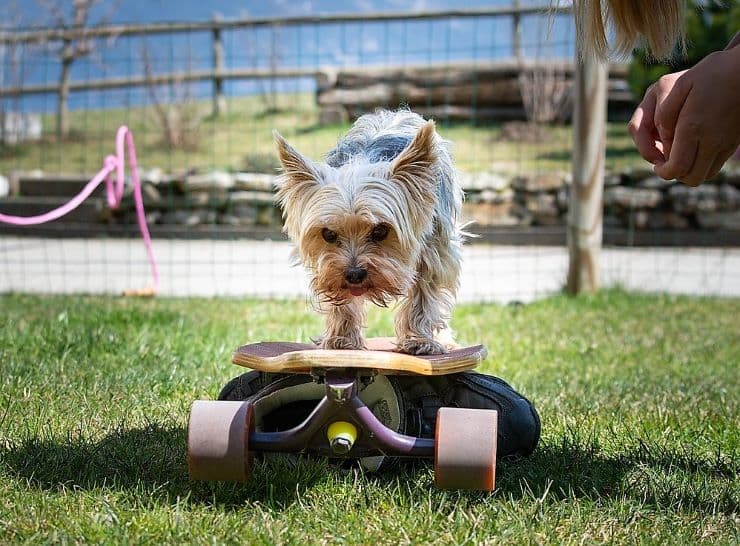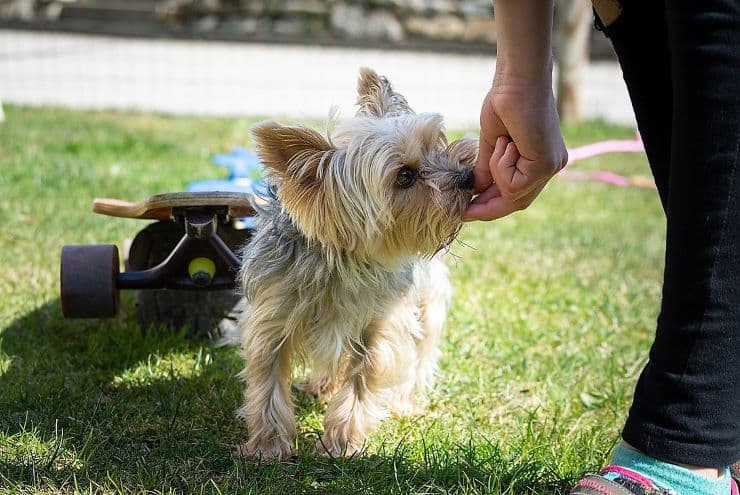Having a small dog is both a joy and a challenge. As a trainer, I found that the key to a harmonious relationship with these dogs is effective training. I've had my share of good and bad days. But I'm here to help you make yours good and skip the bad ones.
For that, I'll take you through the importance of positive reinforcement, the art of selecting the right rewards, the role of consistency, and much more. Whether you're introducing commands or incorporating them into daily routines, my tips will guide you every step of the way.
I'll also share with you my way of training a small dog with a vibration collar without inflicting any pain or leading the dog down the path of distrust.
Without further ado, let's get your puppy well-behaved and turn it into a happy little companion.

Photo Credit: Pezibear/Pixabay
The Importance of Positive Reinforcement
There is no denying that positive reinforcement stands out as the most recommended training method by vets. Simply put, it's about rewarding your dog for good behavior, rather than focusing on punishing their misdeeds. This approach works wonders, especially for small breeds, but the fact also remains that it's time-consuming.
A study in applied Animal Behavior Science highlighted that when small dogs received similar training to their larger counterparts, both exhibited equal levels of obedience. Therefore, it's the quality of training that works the best, and positive reinforcement is definitely on the top.
However, there are downsides to it if your method fails to achieve the right objective. You see, it's essential to be watchful about intentionally rewarding unwanted actions. For example, rewarding a dog that barks for attention or play will definitely result in further encouraging it to bark. You have to wait for them to calm down before feeding the treats to prevent reinforcing any undesirable habits.
The Role Of Training Collars
As compared to positive reinforcement, a training collar relies on negative reinforcement. It is the name given to associating a dog's unwanted behavior with an uncomfortable situation or feeling that results in stopping them from exhibiting that behavior in the future.
Yes, there is an element of fear involved in it, but it is for the best sometimes. As I mentioned earlier, using positive reinforcement can bear fruits but it's time-consuming. In an event where you have to train a dog to stop it from lunging onto speeding cars or running in the neighborhood without caring about the traffic, relying on time-consuming training methods seems counterproductive.
That is exactly when I suggest owners learn using controlling devices like a training collar.
Understand that this equipment gets a lot of flak for inflicting pain or destroying the dog's skin. While all of that could be true, it highly depends on the owner using the equipment.
Besides learning to use a training collar, selecting the right product for your dog according to its temperament, size, breed, and bearing capacity also stands crucial in saving it from any training collar-related harm.

Photo Credit: Pezibear/Pixabay
You see, using this equipment is a process rather than a switch that you turn on and everything gets okay.
- You have to learn to use the equipment.
- You have to buy the right product.
- Almost all products come with three stimulation types. Using the right type depends on your dog. Throughout my experience as a trainer, I have seen that some dogs refrain from doing something just by the vibration or the tone. Others, the most stubborn ones, require the last type, which is the static shock.
- Even stimulations have levels and you have to choose the one that does not hurt your dog. The best practice is to select the level beyond which your dog shouts for help or seems confused. You may also see it jumping around or coming to you for help.
- Besides considerations related to the use of a training collar, it's also an owner's conscious effort to not stimulate the dog for punishment that matters the most in keeping him healthy.
How to Use Both Positive Reinforcement and a Training Collar
As a trainer, I have used both these techniques in tandem many times and they have produced encouraging results.
1. Understanding and Finding the Right Reward
Choosing the right reward is an important step in training your small dog. Here's how I do it:
- Identify your dog's motivations because dogs vary in their preferences. While many dogs light up at the side of a treat, others might prefer a game of tug of war.
- Experiment with treats as some dogs favor soft, chewy treats over hard, crunchy ones. In my opinion, the best treats are those that are both palatable and healthy. You should take into account your dog's digestive sensitivity before choosing any treat.
- When the dog exhibits the right behavior after you correct it with a training collar, you can use these treats or his favorite reward to positively reinforce the idea.
2. Be Consistent
Consistency is the backbone of effective dog training. For small dogs, with their lively personalities, understanding clear boundaries plays a major role. Here's how to maintain consistency:
- Always use the same words when training. A command like "sit" should always sound the same every time to avoid confusing the dog.
- Ensure that everyone in the house knows all the rules and training guidelines. For example, if one household member allows the dog on the couch while the other doesn't, it confuses the pup. Also, make sure that not everyone has access to the remote control of a training collar. You have to discourage each and every chance of correcting the dog unnecessarily.
- Make sure that your training sessions are integrated well into daily routines. I always tend to ask a dog to follow my command before or after walks. Remember that dogs are animals of routine.

Photo Credit: Pezibear/Pixabay
3. Structure the Training Sessions Well
For small dogs, effective training isn't just about what you teach, but how you teach it. Make sure that your training sessions are short, frequent, done over diverse locations, integrated into playtimes, and broken down into easy-to-understand commands. Monitor your dog's response closely not only to the training collar but also to your training sessions.
4. Correct the Dog Right On Point
As it is with positive reinforcement, correcting the dog at the right time also means a lot when using a training collar. You have to make sure that the dog does not correlate the stimulation with anything before or after the actual behavior because that will ultimately train the dog for the wrong thing.
5. Go Beyond the Usual Basic Commands
While you can use positive reinforcement when teaching the dog basic commands as taking time in teaching these does not matter, delaying a dog's learning in crucial situations such as stopping it from escaping or barking unnecessarily may put it in harm's way.
That's one of the reasons why I am an advocate of using training collars in dire situations.
Therefore, use the equipment humanely and within the bounds acceptable to stop the dog from escaping, barking unnecessarily, counter surfing, destroying furniture, chasing children, chasing other small pets, getting into fights too often, getting distracted a lot during walks or hunts, nipping and biting, and anything that requires an immediate solution.
6. Use Visual and Vocal Signals In Training
Dogs often respond more to visual cues because of their keen sense of observation. Hand signals, for example, offer a clear and direct method of communication with your companion. By using the signals for specific behaviors, you trigger their natural instincts of reading your body language which can result in quicker comprehension and response time.
Combine verbal commands with hand signals more effectively, for instance, use a specific gesture when saying "sit". With time your dog will begin to associate both the word and the gesture with the desired behavior.
7. Seek Professional Help
What I shared above are some of the tips from my experience that may come in handy when you're training the dog yourself. However, using a training collar and positive reinforcement together may be overwhelming, especially for a new owner. In that case, you can get help from a professional. You may also need a professional's guidance when the dog does not respond to anything you do as some of the small dogs such as Chihuahuas can easily challenge your training methods by identifying your underlying motive.
In Conclusion
Training a small dog may require a new approach. I have paired the use of a training collar with positive reinforcement techniques and that has paved the way for successful training. You can do this also, but it's highly important that you first know the harm that you can inflict upon your companion by misusing a training collar. You see, it's not just about commands but building a bond with your dog that can clearly be shattered by such misuse.
Also, remember that consistency ensures clarity which leads to longer and reliable results. Embrace the process and train your dog with patience. Happy training!
Read More: Dog Training Articles from a Russian Dog Wizard

Leave a Reply